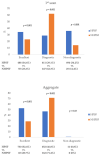Radiation Dose and Image Quality of a High-Pitch Prospective Spiral First Approach in Coronary Computed Tomography Angiography (CCTA)
- PMID: 34677188
- PMCID: PMC8539421
- DOI: 10.3390/jcdd8100119
Radiation Dose and Image Quality of a High-Pitch Prospective Spiral First Approach in Coronary Computed Tomography Angiography (CCTA)
Abstract
Objective: To investigate a high-pitch spiral first (HPSF) approach for coronary computed tomography angiography (CCTA) in an unselected patient cohort and compare diagnostic yield and radiation exposure to CCTAs acquired via conventional, non-high-pitch spiral first (NHPSF) scan regimes. Materials and Methods: All consecutive patients from 1 January 2015 to 31 December 2017 were included. Two investigation protocols (HPSF/NHPSF) were used with the aim to achieve diagnostic image quality of all coronary segments. Low-pitch secondary scans followed the initial examination if image quality was unsatisfactory. Dosage and image quality were compared between both regimes. Results: 1410 patients were subject to a HPSF and 236 patients to a NHPSF approach. While the HPSF approach led to a higher fraction of re-scans (35% vs. 11%, p < 0.001), the fraction of aggregate scans that remained non-diagnostic after considering the initial and secondary scan was comparably low for the HPSF and NHPSF approach (0.78 vs. 0%, p = 0.18). Aggregate radiation exposure in the HPSF protocol was significantly lower (1.12 mSv (IQR: 0.73, 2.10) vs. 3.96 mSv (IQR: 2.23, 8.33) p < 0.001). Conclusions: In spite of a higher number of re-scans, a HPSF approach leads to a reduction in overall radiation exposure with diagnostic yields similar to a NHPSF approach.
Keywords: coronary artery disease; coronary computed tomography angiography; high-pitch-spiral scan; radiation exposure.
Conflict of interest statement
The authors declare no conflict of interest.
Figures







References
-
- Koplay M., Erdogan H., Avci A., Sivri M., Demir K., Guler I., Demir L.S., Paksoy Y. Radiation dose and diagnostic accuracy of high-pitch dual-source coronary angiography in the evaluation of coronary artery stenoses. Diagn. Interv. Imaging. 2016;97:461–469. doi: 10.1016/j.diii.2015.10.008. - DOI - PubMed
-
- Deseive S., Pugliese F., Meave A., Alexanderson E., Martinoff S., Hadamitzky M., Massberg S., Hausleiter J. Image quality and radiation dose of a prospectively electrocardiography-triggered high-pitch data acquisition strategy for coronary CT angiography: The multicenter, randomized PROTECTION IV study. J. Cardiovasc. Comput. Tomogr. 2015;9:278–285. doi: 10.1016/j.jcct.2015.03.001. - DOI - PubMed
-
- Leber A.W., Knez A., Becker A., Becker C., von Ziegler F., Nikolaou K., Rist C., Reiser M., White C., Steinbeck G., et al. Accuracy of multidetector spiral computed tomography in identifying and differentiating the composition of coronary atherosclerotic plaques: A comparative study with intracoronary ultrasound. J. Am. Coll. Cardiol. 2004;43:1241–1247. doi: 10.1016/j.jacc.2003.10.059. - DOI - PubMed
-
- Austen W.G., Edwards J.E., Frye R.L., Gensini G.G., Gott V.L., Griffith L.S., McGoon D.C., Murphy M.L., Roe B.B. A reporting system on patients evaluated for coronary artery disease. Report of the Ad Hoc Committee for Grading of Coronary Artery Disease, Council on Cardiovascular Surgery, American Heart Association. Circulation. 1975;51:5–40. doi: 10.1161/01.CIR.51.4.5. - DOI - PubMed
LinkOut - more resources
Full Text Sources

